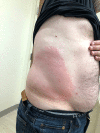Update on mosquito bite reaction: Itch and hypersensitivity, pathophysiology, prevention, and treatment
- PMID: 36211437
- PMCID: PMC9532860
- DOI: 10.3389/fimmu.2022.1024559
Update on mosquito bite reaction: Itch and hypersensitivity, pathophysiology, prevention, and treatment
Abstract
Mosquito bites are endured by most populations worldwide. Reactions to mosquito bites range from localized wheals and papules with associated pruritus to rare systemic reactions and anaphylaxis in certain populations. The mechanism of itch is due to introduction of mosquito saliva components into the cutaneous tissue, although the exact pathophysiology is unclear. Histamine is thought to be a key player through mosquito saliva itself or through activation of mast cells by IgE or through an IgE-independent pathway. However, other salivary proteins such as tryptase and leukotrienes may induce non-histaminergic itch. Some individuals have a genetic predisposition for mosquito bites, and people with hematologic cancers, HIV, and other conditions are susceptible to robust reactions. Prevention of mosquito bites is key with physical barriers or chemical repellents. Treatment consists of second-generation antihistamines and topical corticosteroids. Further research on topical treatments that target neural-mediated itch is needed.
Keywords: genetic predisposition; hypersensitivity; insect bite; itch; mosquito; mosquito allergy; repellant.
Copyright © 2022 Vander Does, Labib and Yosipovitch.
Conflict of interest statement
GY conducted clinical trials or received honoraria for serving as a member of the Scientific Advisory Board and consultant of Pfizer, TREVI, Regeneron, Sanofi, Galderma, Novartis, Bellus, Kiniksa, and Eli Lilly and received research funds from Pfizer, Leo, Sanofi, Regeneron, Eli Lilly, and Novartis. The remaining authors declare that the research was conducted in the absence of any commercial or financial relationships that could be construed as a potential conflict of interest.
Figures


Similar articles
-
Roles of mast cells and histamine in mosquito bite-induced allergic itch-associated responses in mice.Jpn J Pharmacol. 2001 May;86(1):97-105. doi: 10.1254/jjp.86.97. Jpn J Pharmacol. 2001. PMID: 11430478
-
Immunology and treatment of mosquito bites.Clin Exp Allergy. 1990 Nov;20 Suppl 4:19-24. doi: 10.1111/j.1365-2222.1990.tb02472.x. Clin Exp Allergy. 1990. PMID: 1980855 Review.
-
[Mosquito allergy].Duodecim. 2013;129(13):1362-7. Duodecim. 2013. PMID: 23901737 Finnish.
-
Are we really allergic to mosquito bites?Ann Med. 1994 Aug;26(4):301-6. doi: 10.3109/07853899409147906. Ann Med. 1994. PMID: 7946248 Review.
-
Comparison of cetirizine, ebastine and loratadine in the treatment of immediate mosquito-bite allergy.Allergy. 2002 Jun;57(6):534-7. doi: 10.1034/j.1398-9995.2002.13201.x. Allergy. 2002. PMID: 12028119 Clinical Trial.
Cited by
-
Evaluation of Lactococcus lactis carrying active For t 2 protein in immunotherapy for Forcipomyia taiwana allergy in mice.World Allergy Organ J. 2025 Jun 11;18(7):101073. doi: 10.1016/j.waojou.2025.101073. eCollection 2025 Jul. World Allergy Organ J. 2025. PMID: 40584685 Free PMC article.
-
An Overview of D7 Protein Structure and Physiological Roles in Blood-Feeding Nematocera.Biology (Basel). 2022 Dec 26;12(1):39. doi: 10.3390/biology12010039. Biology (Basel). 2022. PMID: 36671732 Free PMC article. Review.
-
Aedes albopictus salivary adenosine deaminase is an immunomodulatory factor facilitating dengue virus replication.Sci Rep. 2023 Oct 4;13(1):16660. doi: 10.1038/s41598-023-43751-1. Sci Rep. 2023. PMID: 37794048 Free PMC article.
-
Practical guide for the diagnosis and treatment of localized and generalized cutaneous pruritus (chronic itch with no underlying pruritic dermatosis).J Dermatol. 2025 Feb;52(2):204-220. doi: 10.1111/1346-8138.17565. Epub 2024 Dec 12. J Dermatol. 2025. PMID: 39663861 Free PMC article. Review.
-
Ultrasound evaluation of superficial lesions caused by ectoparasites in children.Pediatr Radiol. 2025 May;55(5):902-913. doi: 10.1007/s00247-024-06101-5. Epub 2024 Nov 26. Pediatr Radiol. 2025. PMID: 39589489 Review.
References
-
- Seda J, Horrall S. Mosquito bites. In: StatPearls. Treasure Island (FL: StatPearls Publishing; (2021). - PubMed
-
- Rueda LM. Global diversity of mosquitoes (Insecta: Diptera: Culicidae) in freshwater. Hydrobiologia (2008) 595:477–87. doi: 10.1007/s10750-007-9037-x - DOI
-
- Caraballo H, King K. Emergency department management of mosquito-borne illness: malaria, dengue, and West Nile virus. Emerg Med Pract (2014) 16(5):1–24. - PubMed
Publication types
MeSH terms
Substances
LinkOut - more resources
Full Text Sources
Medical
Research Materials

